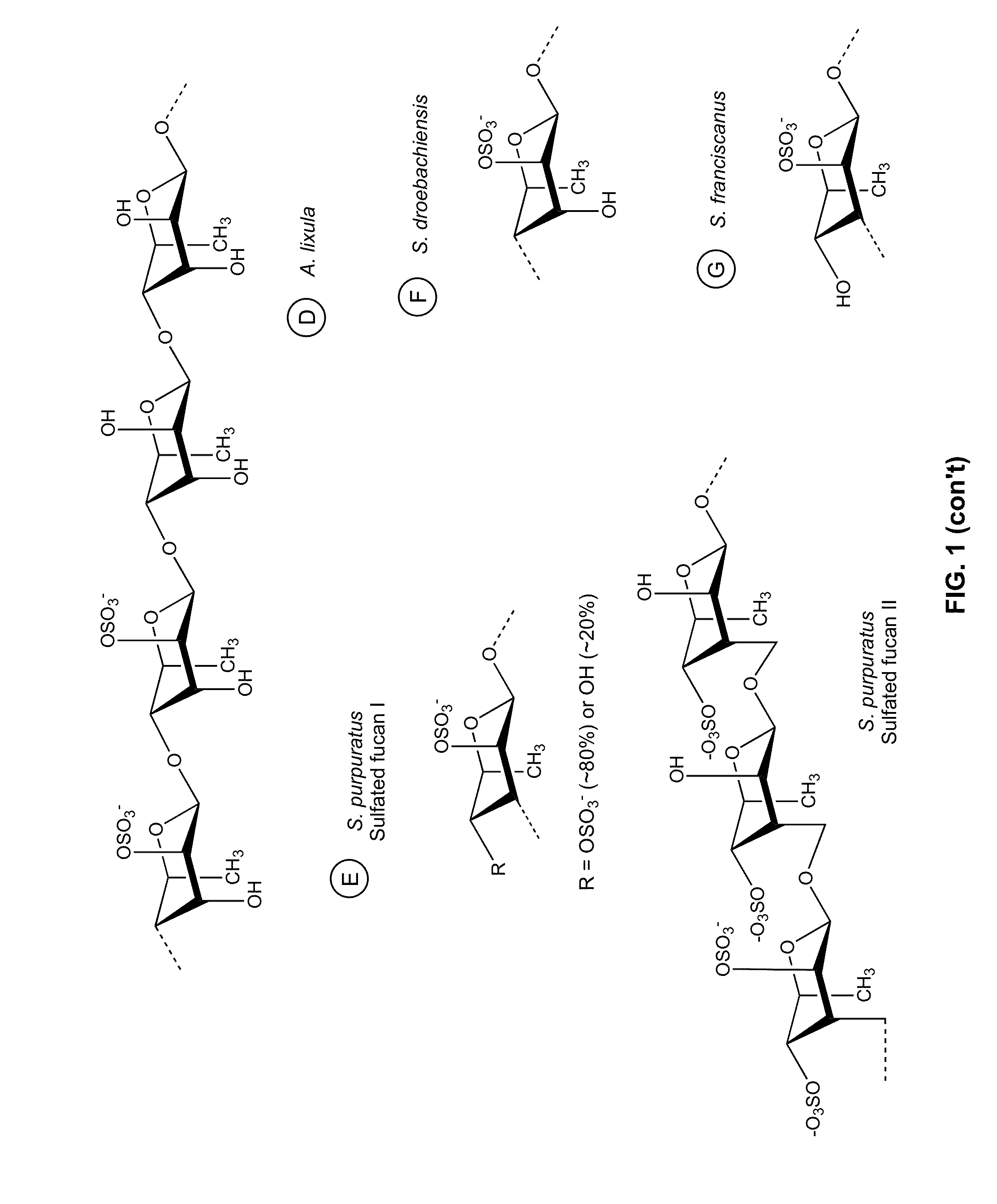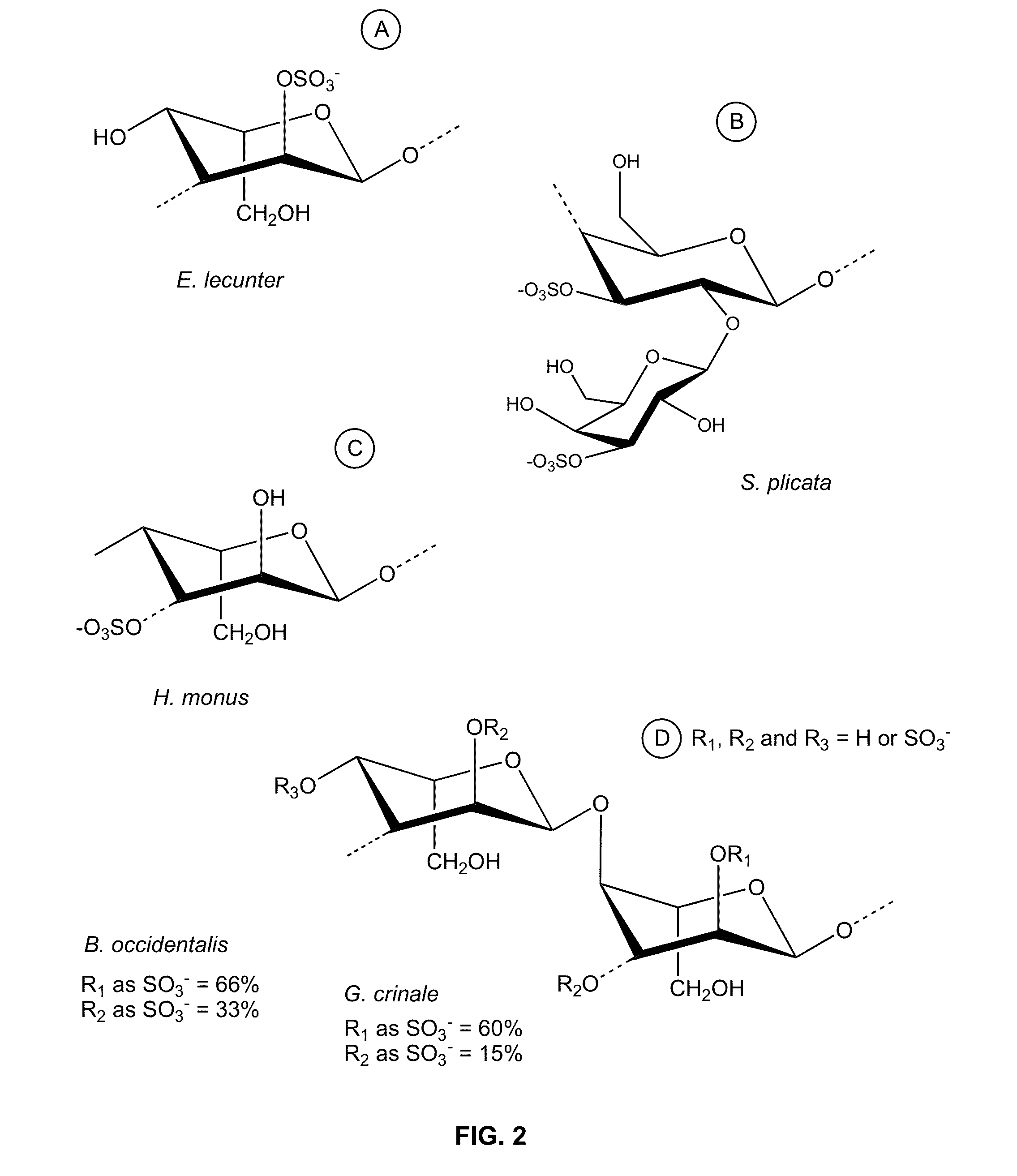Therapeutic Sulfated Polysaccharides, Compositions Thereof, and Methods for Treating Patients
- Summary
- Abstract
- Description
- Claims
- Application Information
AI Technical Summary
Benefits of technology
Problems solved by technology
Method used
Image
Examples
example 1
Disaccharide Analysis
[0232]Purified heparin sulfate (HS) from the endothelial cells (EC) exposed or not exposed to RS #2 were incubated with a mixture of heparin lyases (heparinase I and II, 2.5 mlU each, available from Sigma) and the disaccharides produced by the enzymatic action were separated on a Phenosphere SAX column (Phenomenex, Torrance, Calif., USA) 150×4.6 mm using a NaCl gradient of 0-1 M in 30 min with a flux of 1 mL / min. Individual fractions (0.5 mL) were collected and counted using a micro-beta counter. FIG. 4 shows the relative percentage of the sulfated disaccharides, where CTR is the control cell fraction. As is apparent, the HS synthesized by the EC cells exposed to RS #2 show a significant increase in heparin sequences composed of the tri-sulfated disaccharide (ΔU2S-GlcNS,6S). The abbreviations used in the figure are: GlcNS(6S)=2-deoxy-6-O-sulfo-2-(sulfoamino)-α-D-glucopyranoside; GlcA=β-D-glucopyranuronosyl; GlcNS(3S,6S)=2-deoxy-3,6-di-O-sulfo-2-(sulfoamino)-α-D-...
example 2
LDL Permeability and Water Flux
[0234]To test whether any of the RS isoforms could inhibit apoptosisn in human coronary artery endothelial cells (HCAEC), the HCAEC (human coronary artery endothelial cell) monolayers were incubated with each of two isoforms, RS#1 or RS#2, at concentrations ranging from 12.5 to 12004 / mL for a period of time ranging from 24 hrs to 5 day, before the permeability of LDL (low density lipoprotein) was measured. In addition, some monolayers were induced to undergo apoptosis with TNF-α / CHX in the presence or absence of RS#1 or RS#2 and the permeability of LDL was measured. As shown in the figure, Dil means 11′-dioctadecyl-3,3-3′,3′-tetramethylindo-carbocyanide perchlorate. Both RS#1 and RS#2 significantly reduced the LDL permeability of control monolayers by 5-fold (FIGS. 6 and 7). When the monolayers were induced to undergo apoptosis the permeability increased by ˜2-3-fold. Incubation with RS#1 completely abolished the TNF-α / CHX-induced increase in permeabil...
example 3
Heparan Sulfate Immunostaining
[0236]HCAEC monolayers were incubated with RS#1 at 1004 / mL for 24 hrs and immunostaining for heparan sulfate was performed. The monolayers were then imaged using a laser scanning confocal microscope. One control and one RS#1-treated monolayers were stained and four representative fields from each case were imaged. In control monolayers, heparan sulfate immunostaining seemed to be concentrated on the cell-cell junction area (FIG. 9A). Incubation to RS#1 increased the coverage of heparan sulfate on HCAEC monolayers (FIG. 9B). These results indicated that RS dramatically decreases LDL permeability even in the face of the very potent permeability enhancer and toxin TNF (tumor necrosis factor). They also show that this effect is related to ECM heparan production and localization at the endothelial cell-cell junctions.
[0237]These results also show that RS from Monostroma nitidum decreases permeability of LDL across the endothelium by ninety-three percent, an ...
PUM
| Property | Measurement | Unit |
|---|---|---|
| Percent by mass | aaaaa | aaaaa |
| Percent by mass | aaaaa | aaaaa |
| Therapeutic | aaaaa | aaaaa |
Abstract
Description
Claims
Application Information
 Login to View More
Login to View More - R&D
- Intellectual Property
- Life Sciences
- Materials
- Tech Scout
- Unparalleled Data Quality
- Higher Quality Content
- 60% Fewer Hallucinations
Browse by: Latest US Patents, China's latest patents, Technical Efficacy Thesaurus, Application Domain, Technology Topic, Popular Technical Reports.
© 2025 PatSnap. All rights reserved.Legal|Privacy policy|Modern Slavery Act Transparency Statement|Sitemap|About US| Contact US: help@patsnap.com



